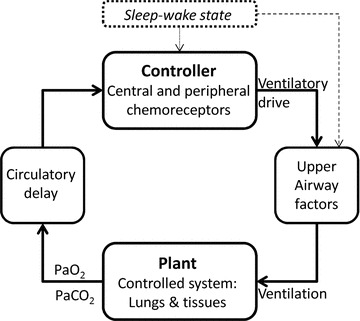One of the purposes of modelling the control of breathing is to improve our understanding of how the system works, so new effective therapies can be developed. Current therapies, e.g. surgery, continuous positive airway pressure (CPAP) and dental devices for obstructive sleep apnoea (OSA), are often uncomfortable and sometimes poorly tolerated. In a recent issue of The Journal of Physiology, Edwards et al. (2012) report the results of an interesting experiment in which they used acetazolamide to reduce the severity of OSA, in a group of 12 volunteers who were known to be compliant users of CPAP therapy. They used the modelling concept of ‘loop gain’ to explain the benefits of acetazolamide.
The concept of ‘loop gain’ is used to quantify the internal amplification of a system (Grodins et al. 1967). It is a dimensionless value of the propensity of a system governed by feedback loops to develop unstable behaviour. Respiration is such a system (Strohl et al. 2007). The gain can be influenced by control of variables relating to hypercapnic and hypoxic ventilatory responses (controller gain), or the ability to eliminate CO2 and the size of oxygen stores (plant gain) (Younes 1989). Circulation time has an effect on the interaction between ventilation and controller gain. Upper airway factors (e.g. resistance) have effects on the interaction between controller gain and ventilation (Younes 1989). The presence of sleep reduces controller gain relative to wakefulness, and more importantly upper airway tone, particularly in rapid eye movement sleep (REM) (see Fig. 1). The higher the loop gain, the potentially more unstable the respiratory control system becomes. A high loop gain promotes recurrent apnoeas as a response to an initial disturbances, such as a sigh, because it is over compensated, while a low loop gain dampens subsequent oscillations in breathing. Although the early modelling was done for central sleep apnoea (Cherniack 1981), the principles have more recently also been applied to obstructive sleep apnoea (White 2005).
Figure 1. A very simplified diagram of the control of breathing during sleep, showing the relationship between ventilation and the two gains in the feedback system.

Sleep state has important effects on upper airway tone and the controller output. See Younes (1989) for more detail.
In the experiments under discussion, the subjects underwent repeated drops in CPAP pressure during Stage 2 non-REM sleep to induce prolonged hypopnoeas and then the CPAP pressure was returned to normal, which was associated with an overshoot of ventilation. Loop gain was calculated by dividing ‘the response’ (the overshoot in ventilation after CPAP pressure was restored) by ‘the stimulus’ (the difference between ventilation during the induced hypopnoea and the calculated zero ventilation) which the authors used as a surrogate for the physiological stimuli to ventilation, (alterations in blood gas tensions in the brain and carotid bodies, increases in pleural pressure and other factors). The acetazolamide was given 500 mg BID for 1 week without placebo control and the subjects underwent two nights’ study in a sleep laboratory, one night without CPAP and on other they underwent a complicated experiment to measure loop gain.
Edwards et al. found an approximate 50% reduction in the apnoea–hypopnoea index (AHI) with acetazolamide therapy compared to control night, and this was associated with an approximate 40% reduction in loop gain. Parameters of upper airway function were not significantly changed.
Oral acetazolamide administration typically causes a metabolic acidosis. In these experiments, on the non-CPAP night it caused an increase in resting ventilation due to an increase in tidal volume and a fall in serum bicarbonate and end tidal  , with an associated increase in arterial saturation. There was an increase in serum urea and creatinine values to suggest some degree of dehydration, but this is unlikely to be important.
, with an associated increase in arterial saturation. There was an increase in serum urea and creatinine values to suggest some degree of dehydration, but this is unlikely to be important.
The authors state that the acetazolamide acted predominantly via lowering plant gain, because the measured changes in end tidal gas values, saturation and bicarbonate are more likely to represent changes in plant gain than controller gain. Nevertheless, the article provides new insights into the control of breathing in patients with OSA and provides a stimulus for future therapeutic strategies that modify gain rather than the upper airway. Unfortunately acetazolamide in high dosage is poorly tolerated in long term usage. So, some challenges remain: firstly, to confirm their findings with direct assessment of controller gain; subsequently to develop other drugs that are better tolerated, to either complement or replace the sometimes uncomfortable current therapies for OSA.
References
- Cherniack NS. N Engl J Med. 1981;305:325–330. doi: 10.1056/NEJM198108063050606. [DOI] [PubMed] [Google Scholar]
- Edwards BA, Sands SA, Eckert DJ, White DP, Butler JP, Owens RL, Malhotra A, Wellman A. J Physiol. 2012;590:1199–1211. doi: 10.1113/jphysiol.2011.223925. [DOI] [PMC free article] [PubMed] [Google Scholar]
- Grodins FS, Buell J, Bart AJ. J Appl Physiol. 1967;22:260–76. doi: 10.1152/jappl.1967.22.2.260. [DOI] [PubMed] [Google Scholar]
- Strohl KP, Yamauchi M, Dick TE. Curr Resp Med Rev. 2007;3:85–92. [Google Scholar]
- Younes M. Curr Pulmonol. 1989;10:265–326. [Google Scholar]
- White DP. Am J Respir Crit Care Med. 2005;172:1363–1370. doi: 10.1164/rccm.200412-1631SO. [DOI] [PubMed] [Google Scholar]


